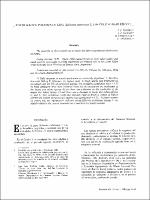| dc.contributor.author | Lucero, J.C | |
| dc.contributor.author | Silenzi, J.C | |
| dc.contributor.author | Verdoljak, M | |
| dc.contributor.author | Andreoli, C. | |
| dc.date.accessioned | 2022-09-06T17:23:41Z | |
| dc.date.available | 2022-09-06T17:23:41Z | |
| dc.date.issued | 1983-01 | |
| dc.identifier.uri | https://repositorio.catie.ac.cr/handle/11554/11970 | |
| dc.description.abstract | The objective of this research was to study the effect of potassium fertilization on potato.
During October 1979 — March 1980 measurements of yield, tuber quality and starch content were made in a field experiment on irrigated soils of the Lower Valley of the Colorado River (Province of Buenos Aires, Argentina).
Treatments consisted of: (0) control; (1) 100, (2) 1.50 and (3) 200 kg K2 Olha and the results obtained showed.
1 ) Yield response to potash application was statiscally significant. 2) Fertilization with 200 kg 1(20/ha gave the highest yield. 3) Total yield in each treatment was correlated with the rate of potassium applied; the correlation coefficient was r = 0.77 4) When potassium rates were increased there was an increase on the production of the largest size tubers (group A) and there was a decrease on the production of the largest size tubers (group A) and there was a decrease of lower size tubers (groups C, and 5). The correlation coefficient between yield of group A tubers of highest commerical quality and potassium applied was significant (r = 0.75).5) Starch content on tubers was not significantly different along different treatments though it was slightly higher in the control treatments as it was their dry matter content. | es_ES |
| dc.description.abstract | El objetivo de esta investigación fue estudiar el efecto de la fertilización potásica sobre la papa.
Durante octubre de 1979 - marzo de 1980 se realizaron mediciones de rendimiento, calidad del tubérculo y contenido de almidón en un experimento de campo en suelos irrigados del Valle Inferior del Río Colorado (Provincia de Buenos Aires, Argentina).
Los tratamientos consistieron en: (0) testigo; (1) 100, (2) 1,50 y (3) 200 kg K2 Olha y los resultados obtenidos mostraron.
1) La respuesta del rendimiento a la aplicación de potasa fue estadísticamente significativa. 2) La fertilización con 200 kg 1(20/ha dio el mayor rendimiento. 3) El rendimiento total en cada tratamiento se correlacionó con la dosis de potasio aplicada; el coeficiente de correlación fue r = 0.77 4) Al aumentar las dosis de potasio hubo un incremento en la producción de los tubérculos de mayor tamaño (grupo A) y hubo una disminución en la producción de los tubérculos de menor tamaño (grupos C, y 5). El coeficiente de correlación entre el rendimiento de los tubérculos del grupo A de mayor calidad comercial y el potasio aplicado fue significativo (r = 0,75).5) El contenido de almidón en los tubérculos no fue significativamente diferente a lo largo de los distintos tratamientos aunque fue ligeramente superior en los tratamientos control al igual que su contenido de materia seca. | es_ES |
| dc.format.extent | 8 páginas | es_ES |
| dc.language.iso | es | es_ES |
| dc.publisher | Instituto Interamericano de Cooperación para la Agricultura (IICA) | es_ES |
| dc.relation.ispartof | Turrialba; Vol. 33, no. 1 | es_ES |
| dc.subject | ABONOS POTASICOS | es_ES |
| dc.subject | SOLANUM TUBEROSUM | es_ES |
| dc.subject | CULTIVO | es_ES |
| dc.subject | RIEGO | es_ES |
| dc.subject | ARGENTINA | es_ES |
| dc.subject | POTASH FERTILIZERS | es_ES |
| dc.subject | SOLANUM TUBEROSUM | es_ES |
| dc.subject | CULTIVATION | es_ES |
| dc.subject | IRRIGATION | es_ES |
| dc.subject.other | Sede Central | es_ES |
| dc.title | Fertilización potásica de papa (Solanum tuberosum L.) en cultivo bajo riego | es_ES |
| dc.title.alternative | Potash fertilization of potato (Solanum tuberosum L.) under irrigation conditions. | es_ES |
| dc.type | Artículo | es_ES |
| dc.identifier.status | openAccess | es_ES |


